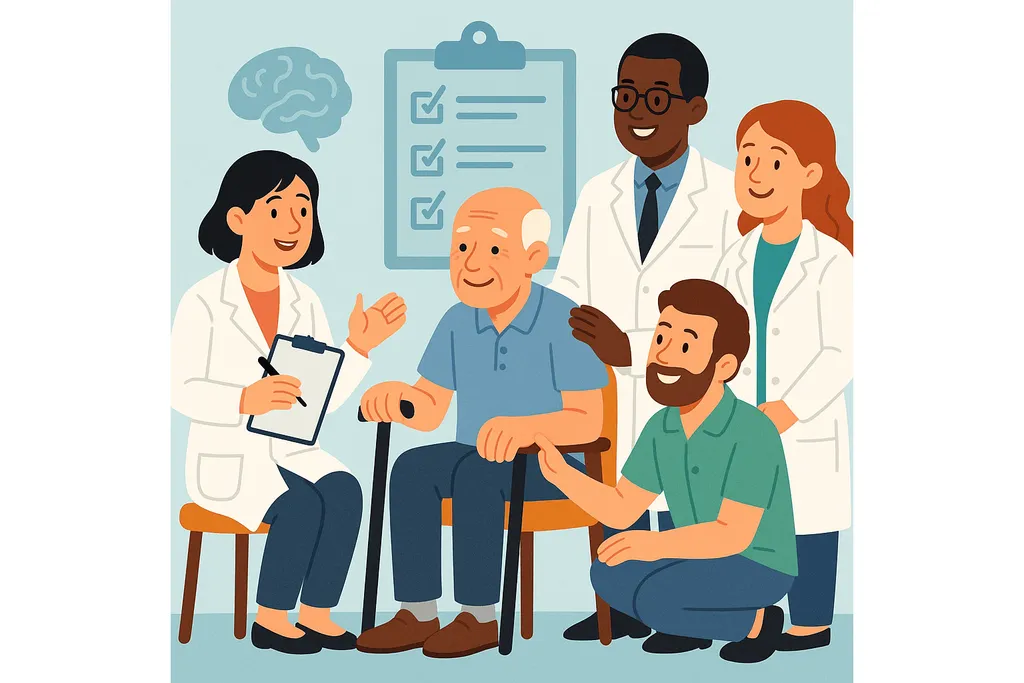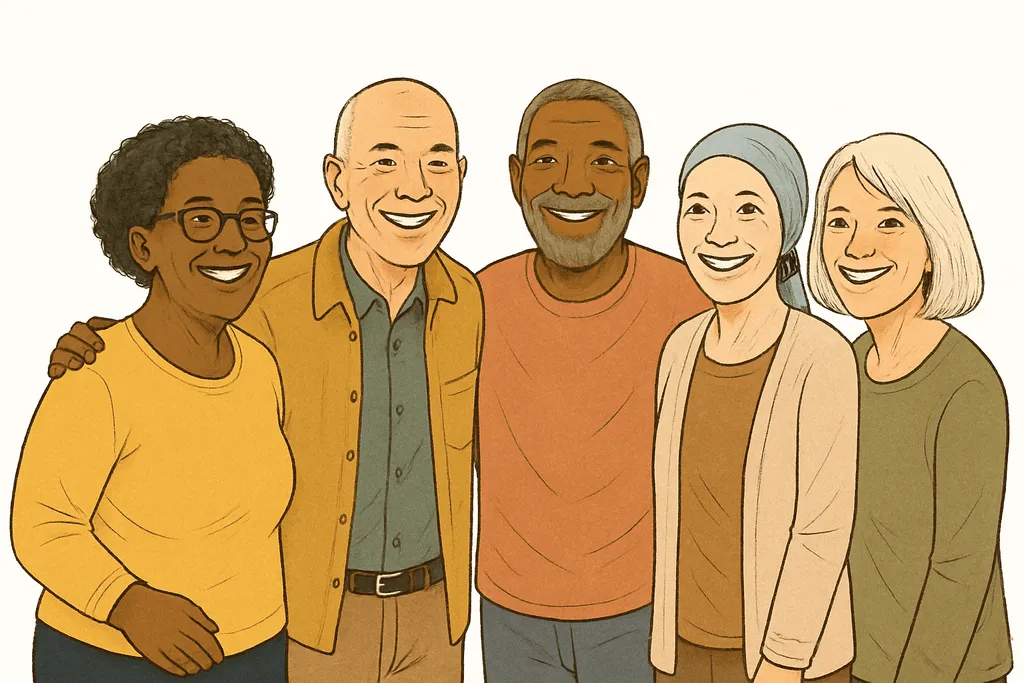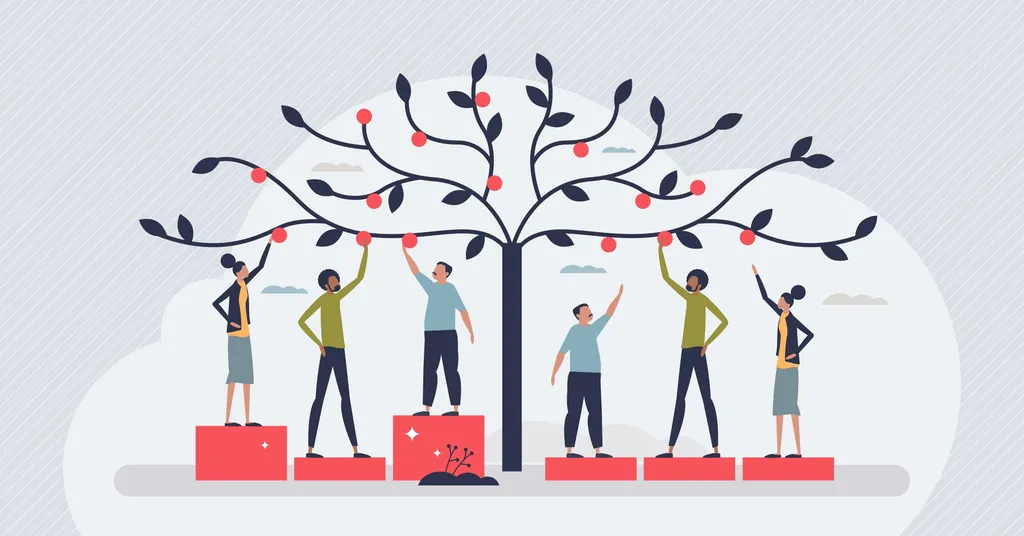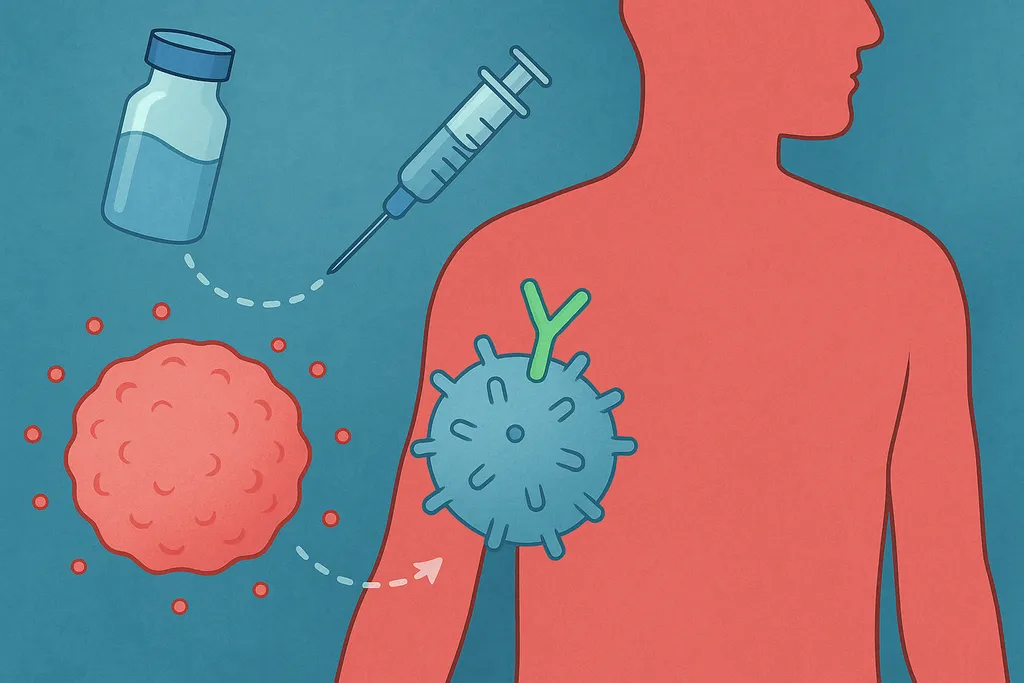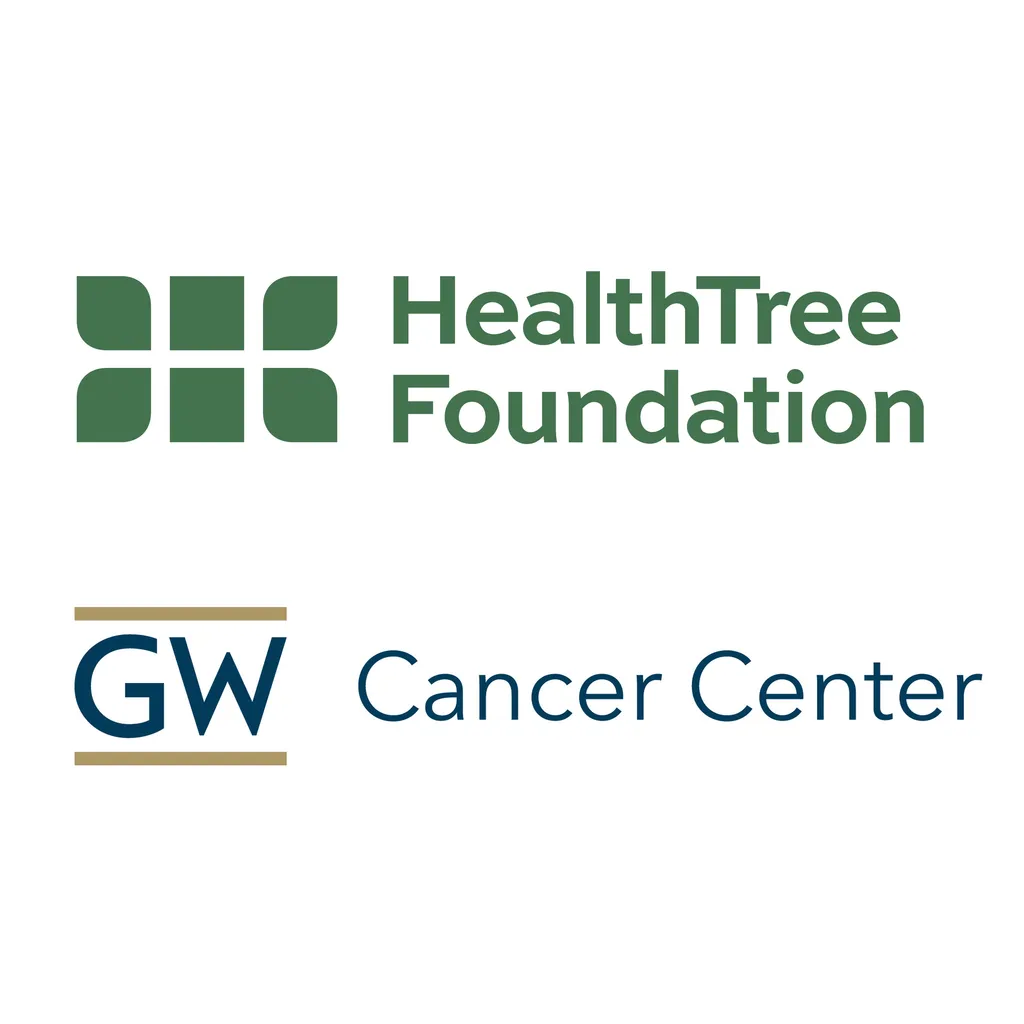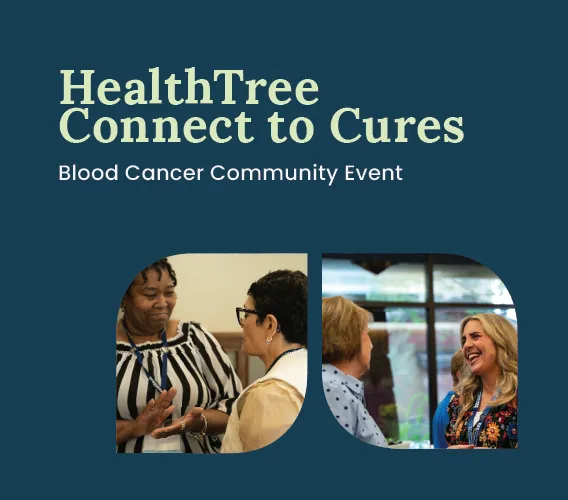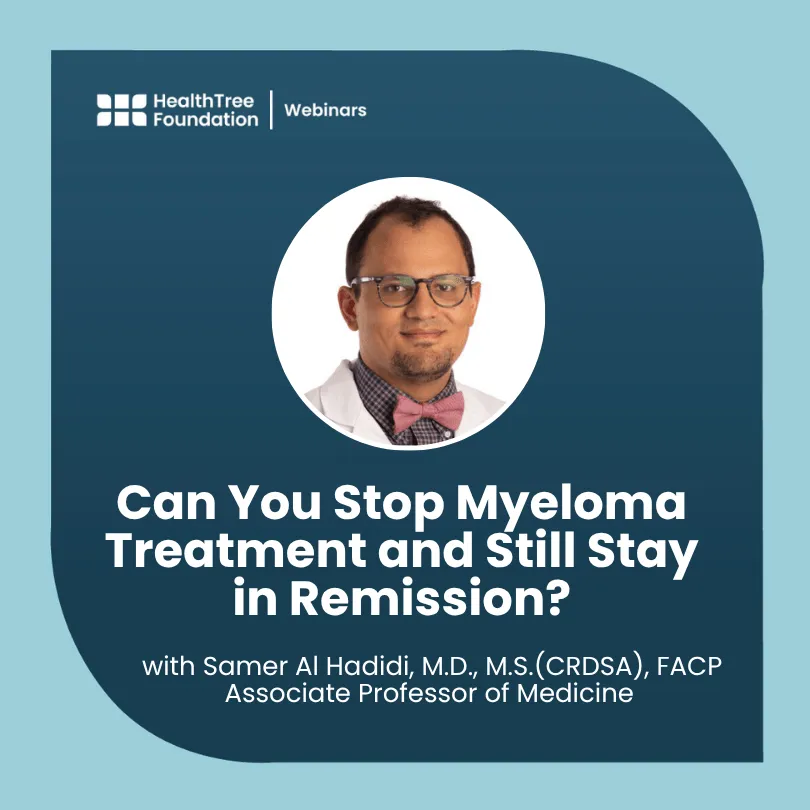Full Show: Exploring Innovative Immunotherapy with Drs. Jim Allison and Pam Sharma
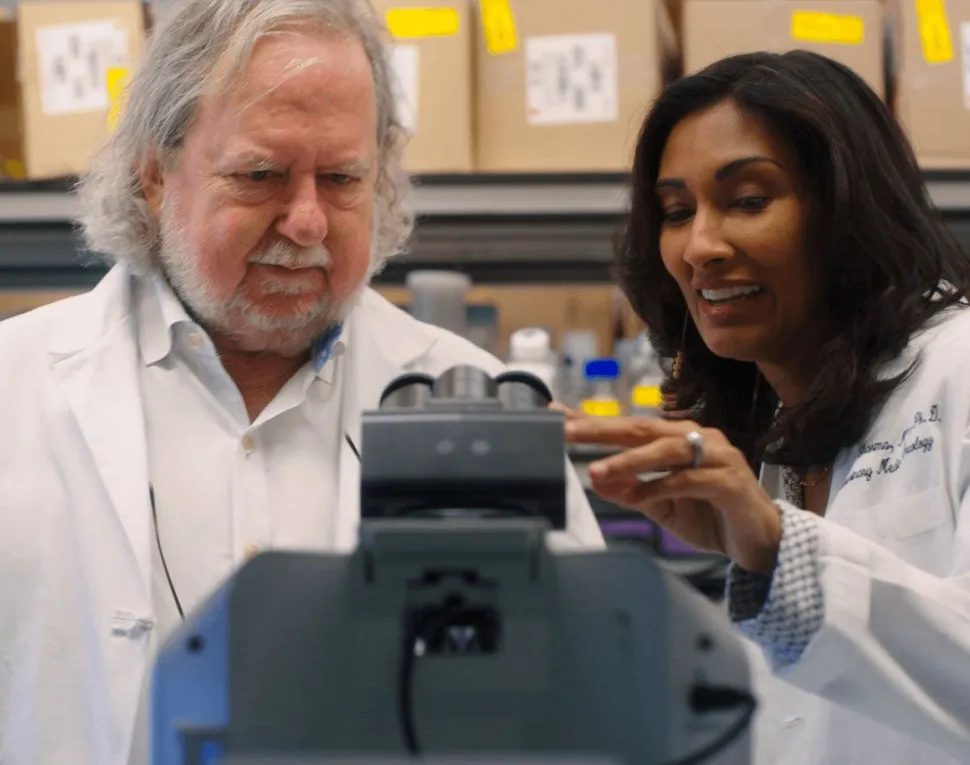
According to Dr. Jim Allison, the key to a cure to cancer can be found not in home runs, but in singles or doubles.
During an intriguing hour-long interview fueled with pre-submitted questions from patients and caregivers like you, we discussed not only what the future of immunotherapy could look like, but what we need to look for within that future to discover cures to cancer through innovative chemo and immunotherapy.
Jenny Ahlstrom, the founder of the HealthTree Foundation (consisting of the Myeloma Crowd and the HealthTree Community for AML), moderated this event and was able to guide both an informative and emotional discussion that you can watch here or read the full transcript of below.
Hear more from experts like Drs. Allison and Sharma in our Immunotherapy Treatment Chapter. Sign up today!
Full Transcript:
Jenny: What were the key factors of your success and what is replicable in that success?
Dr. Allison: The key to success is that I really wanted to understand the mechanisms. I’m a scientist. I didn’t get into this directly to say I am going to find a cure to cancer, I got into this to understand how the immune system works. And then every time I describe and understand a step that regulates immune responses, I will think about how we might be able to use that or not and move on. It was basic science, it was data. When I had the idea that taking these negative checkpoints off, blocking them, and letting T-Cells do their thing without inhibition for a time, we decided to try it after 15 years of work. Anyone could tell me it wasn’t going to work, but I was armed with knowledge and knew it would work. I knew more than anyone, if they wanted to disagree they could analyze the data to see whether I was right or wrong, they couldn’t tell me in ignorance that it wasn’t going to work.
Dr. Sharma: It’s all about following the science. If you stay true to the science and look at what the data is showing you, and follow that up with experiments to test hypotheses to make sure that you are looking at your data in multiple different ways and truly understand what the data is telling you about that specific mechanism that you can move forward into how you can translate that into the clinic. Make sure you follow the basic science and have that understanding.
Jenny: What else was successful in your process from start to finish?
Dr. Allison: I had to convince doctors that drugs to combat cancer weren’t ones that necessarily killed cancer cells. With the drug that I developed, it had nothing to do with the cancer cells, it unleashed the immune system. The complete biology was different and therefore it could not be treated the same way in the clinic (i.e. immediate results with cancer cells being killed).
Dr. Sharma: Find collaborators that can look at the data with you and help you move forward. There are going to be many failures, but there are ways you can go back and look at the science carefully enough to say that you are not going to throw away the baby with the bath water. You can sift through the experiment in the data that went wrong and take what went right and bring it with you moving forward.
Jenny: That is a lesson, I think, in any entrepreneurship endeavour. Don’t be afraid to fail. Failure is ok. And sometimes in healthcare, that’s a challenge.
Dr. Allison: That’s an interesting point that you make, don’t be afraid to fail. When I was considering my career path, my dad was a doctor. I realize that in medical training you have to get your head full of facts so that when someone presents in front of you, you can develop the algorithm and say this is how I am going to treat you, but you better be right. The reason I drifted towards science is because I am interested in being on the edge and helping knowledge move forward. You are going to be wrong a lot of the time if you do that. You should celebrate being wrong, not being wrong intentionally, but saying “I learned from my failure and now I am going to move on and not make that mistake again.” All you have to do is be right occasionally in a big way and it pays off.
Jenny: It seems like the system is not necessarily set up to cure diseases. You get what you measure: a lot of researchers are rewarded for grant funding for publishing but there are no cash prizes currently given by these same institutions for scientists and doctors who make advancements to cure diseases. I could see how we could systematically go after the disease and give the inventor of the cure what we would have spent on Medicaid or Medicare that year.
What needs to change in order to replicate your type of success in the system as a whole?
Dr. Allison: I don’t know if there are any simple answers except to stress that science is now funded in three years cycles, so the only way that you are going to be funded is by following other people in little advancements and you always have to have something. But if there is something really revolutionary, there has to be the courage to put the money there: high risk, high yield. There are different entities now beginning to do that more, they set aside a certain amount of money, some money on the consistent dependable research, but some money for those who say “this may be wrong, but if we are right, we are going to be lightyears ahead.”
Jenny: That’s how you looked at it, and you leapfrogged, you did more work that could have been done in 30 years. In my opinion, it would behoove us to encourage more people like you to make this process easier for you to come up with those major advances. Maybe earlier FDA approvals on Phase 2 trials?
Dr. Sharma: We have to make sure that we are investing a lot of money into innovative science. First, innovative science has to be a priority; it can't be an afterthought, instead of making incremental science the big payoff, it should be the innovative, disruptive science. We should be looking for those projects. Second, we should be funding junior investigators at much larger intervals, we need to fund them for longer periods of time than three-five years. There are some organizations that are doing that very well, but not enough. We need the best and the brightest minds to come into science, and if you want that, you have to make science an endeavor that is rewarded. People shouldn’t have to question where their next salary or paycheck comes from, or how they are going to support their families. If you think about it, when you come into the scientific arena, your paycheck for a postdoctoral fellow could be somewhere around 50k a year, and is that enough? Will they be able to support someone and their family? Do we need to do better? If you want to grow the best and the brightest you have to attract them in. It’s how Wall Street does so well, they don’t pay the same kind of salaries that we pay in science, so how do we change that? So how do we do this in science, how do we make sure the scientific projects are funded well enough so they can continue to stay there for a long period of time until we see the big advancements that come forward.
The other thing is the clinical research dollars. Often we are paying lots of money into clinical research for a clinical endpoint: did they have an overall survival benefit, did they get their tumor shrinking? But we aren’t putting enough research dollars into the clinical trials to say did you get a biopsy sample to understand how the drug is really impacting the human immune response, did you get a tissue sample from the tumor to see what the changes were so we can understand why the drug work and why it didn’t work? So we can see what we can do better.
Dr. Allison: You can learn from a failure just as much as you can learn from a success, but there’s no premium on that. Right now, there are 3000 trials of immunotherapeutic agents looking for a clinical signal without any biopsy samples to tell us what happened, if we almost got there. We are looking for a homerun but we should be looking for whether or not we got a double.The one way to know that is if you spend the time to get the data. Every patient should be studied, not just for the clinical endpoint but to analyze what really happened. With this approach, you don’t need 200 patients anymore, you need 20.
Jenny: Why doesn’t that happen now?
It’s a funding issue. Pharma companies want the home run because that is where they are going to get their payout, FDA approval. It’s easier to say the drug didn’t give the clinical endpoint so I am going to move onto the next drug in my pipeline, rather than spend a lot of time and money into understanding why this drug didn’t work. It’s who is involved in making the decisions. Patient advocates and scientists alike need to figure out funding to get a biopsy. Every time that we want to biopsy a patient it’s $5000 dollars. We’re not going to bill this to insurance, it’s research questions, so we need to come up with how to pay for those things.
Dr. Allison: Part of this is because of this new immunotherapy era. Before, cancer was about killing cancer cells, you either killed them or you didn’t. The immune system be damned, it didn’t have anything to do with it. Now we know that the immune system is very complicated. There are myeloid cells that can suppress the T-Cells, the ones that can do the damage, and you have to get them all working in concert. We are learning a lot about how that works on the molecular level, but if you don’t look, you’re not going to say, well I didn’t get 100% there, but I did get 30% there, and if I add other 30% or 40% successful strategies, I can get 100%. That’s the way we have to look at it. It can’t be just one drug that’s going to kill all the cancer cells, that just doesn’t work.
Jenny: That’s fascinating. That could be related to prior lines of therapy, correct? For example, analyzing patients who have been on prior immunotherapies who are now receiving their next line of immunotherapy and discovering what is happening to the patients in this case and how it affects their immune system. Is it better or worse?
Dr. Sharma, you wrote a paper about the standardization of labs and things such as that, do you think that would help advance science faster?
Dr. Sharma: If we share how we are doing the translational research, the standard operation procedures of how samples are collected, how are they being transported to the lab, how are they processed, how are we looking at humane immune responses from these samples, yes I think all those things will help. I don’t want to say standardization to mean we all need to use the same technologies, because I think we need to be innovative in technologies as well, so that if one lab developed a whole new way of looking at myeloid cells, we all should learn for that, so I don’t want to take away that innovation by saying standardization. But I do want to understand how each of us are going about using these terms and how each of our procedures differentiate and if there are ways that worked for Lab A, then Labs B-Z should be using these methods. For getting the samples and moving it into the laboratory in an hour, we were able to move the cells from the operating room/pathology suite to the laboratory. That makes a difference because the cells are alive and we are able to do the assays that we wanted to do. So there are things we can do to optimize and make the process better.
Jenny: How do you teach your students to innovate? You had this personal mission, you were a force of nature, to me you could say persistence but it’s more of a true grit, willing it over the finish line with your deep level of curiosity.
Dr. Allison: What I try to tell my students is, it’s like a band, you have different people with different expertise doing different things. Periodically they present their findings to the group, and say what they think it means. What I challenge everyone in the room to do is “I want you to give me another explanation that is equally as plausible as what I just heard that would fit the data equally as well.” That’s how you move it forward, not assuming things are right when presented and stop because you think you figured it out, but through questioning, questioning, questioning. Is there another explanation? How do you know that it’s true?
In the case of the work that we did with CTLA-4, people assumed it was a positively regulated molecule, what if it’s a negative? That’s black and white- no one asked if it was negative because a negative-regulated molecule had never been found. However, giving a positive is the same thing as taking away a negative. So what is the experiment that you would design to know the difference? That sort of thing.
Jenny: Challenging them to think differently, and pushing them.
Dr. Sharma: Absolutely. We encourage the students to read the literature but to be critical. You can’t just accept everything that you read, be thoughtful. Look at the paper and see if this is the way that you would have done it. Is there a different way that you would have done it or thought about it? And even do that with your own experiments and in lab meetings, do that with each other’s lab presentations. Be disrupters, disruptive thinking is what we hope everyone is participating in when they are within the lab environment.
Dr. Allison: It’s a subtle thing, because you can’t just say, attack, prove somebody wrong. But you can prove that they are wrong in a nice way. Wait a minute, have you thought of this? Then they know you are helping them, and they can think about it in a different way as they move forward with their experiments.
Jenny: Asking questions instead of criticizing is a good way to think about it.
Ok, let’s talk about immunotherapy in general.
Thanks to you, immunotherapy development is growing in the oncology field and we currently have:
- checkpoint inhibitors
- monoclonal, bispecific and trispecific antibodies
- antibody drug conjugates
- T cell therapy
- NK cell therapy
- and vaccines (+ more)
I once asked a myeloma specialist what the optimal cure for myeloma would be and he said “To have your immune system recognize the myeloma and kill it.” I thought that was a pretty good answer.
How do you identify where the immune system has gone wrong for any kind of cancer?
Dr. Allison: What we found was that you could turn the immune system off by recognizing stuff in the wrong way in the wrong context, it’s not all about turning it on but in doing it in a productive way vs unproductive. Find what can be recognized- a myeloma cell, for example.
T-cells can detect a one amino acid change in a protein that might be caused by a mutation associated with cancer. That ultimately can be the goal, although easier stated than done. We understand more about the process, genetically identifying changes, and specifically trying to re-target the T-cells to go after them.
Dr. Sharma: We are trying to learn about each microenvironment. The foundational work that Jim’s lab did was focused on how the immune system regulated. How are T-cells regulated, how do they regulate their function? How do you take advantage of this knowledge to use it in cancer? Now we know it’s not just T-cells: now there are dendritic cells, NK cells, myeloid cells. Again, from a basic science standpoint: how are each of these cells regulated? The basic science part will help us understand how these cells work and how it relates to what we already know about how the T Cell works.
The other thing to think about is: why microenvironment takes advantage of which particular immune evasion tactic. In each microenvironment, you will have to come up with a personalized strategy in order to achieve a cure.
Myeloid cells are shapeshifters, the drug changes and the environment changes: it can help or hurt but you need to figure out which one. It can’t be put into a box. We are just beginning to learn about how that occurs.
Jenny: Is CAR T cell research a result of your immunotherapy advancements?
Dr Sharma: CART Cell therapy is taking advantage of what we know about T-cells. It’s an engineering technique to take advantage of specific antigens. But CAR T is limited to knowing what the antigens are. We are at the tip of the iceberg in understanding these things. There is a lot of research being done to improve on what we currently have.
Dr. Allison: The fundamental difference, CAR T cells didn’t come out of our work, I wanted to unleash T-cells in your body in a natural way, CAR T engineered cells are obviously manufactured, and through our approach you don’t necessarily need to know what the antigen is whereas in CAR T Therapy you have to be absolutely certain what you are targeting to avoid any unintentional targeting of key organs.
Jenny: Will there be a standard panel to know how prepared and engaged your immune system is?
Sharma: The immune system is so dynamic that one test can’t define the status of how well your immune system is working. We can start to have an understanding of what kind of therapies we can give based on how the immune system is doing in that time period. Each patient will have a different level of immune system and we can use precision therapy to find out what works well.
Jenny: Is there a difference in efficacy of immunotherapy between blood and tumor cancers?
Allison: CAR T therapy seems to work better in blood cancers (due to the B cell antigens) vs solid tumors (that have a collection of different cells- there are some antigens you could attack that could be on other organs in your body). Other immunotherapies, such as immune checkpoint therapy, that engage your own immune system work about the same in tumors and blood cancers.
Jenny: What role does precision medicine play in immunotherapy and how can it help in cancers with thousands of genetic mutations like myeloma?
Dr. Allison: The idea was there was “driver mutations” that cause the cancer, growth factor receptors or pathways that tell the cell to divide, but there are a lot of those kinds of pathways, so the problem is with time, the tumor becomes unstable and continues to evolve and divide, chances are that you have more than one genetic mutation within your tumor and by the time you target one genetic mutation, there is another one that is developing.
Dr. Sharma: The way to move forward is common approaches, you can combine an immunotherapy agent with something that is targeting the tumor cell itself. Tumor cell death through chemotherapy can create an initial inflammatory response, and then the small immune response can be enhanced through the immunotherapy checkpoint agent to hopefully result in a complete response.
Dr. Allison: Another way of saying that is your drugs that you can in with the idea of killing a tumor cell is that you have to kill every tumor cell with that drug or you lose. But if you get the immune system involved, you don’t have to kill every tumor cell, you just have to kill enough to alert the immune cells that they are bad guys there and the immune system will take them out.
To tell you the truth: chemotherapies, targeted therapies, radiation therapies need to be changed so that they aren’t trying to kill all of the cancer cells. That’s what causes all the side effects and all the problems. If you try to kill all the cells, you just do damage. Let the immune system help you.
Dr. Sharma: Doing chemo and radiation without immunotherapy is not as successful unless they are adding an immunotherapy drug.
Jenny: The immune system is involved heavily with the microbiome, and the bone marrow microbiome is complicated. What is the relationship between the tumor environment and the microbiome, and how can we personally impact our own microbiome?
Dr. Sharma: We have a general sense of what will impact our microbiome, such as sleep, diet, stress, caffeine, and alcohol. The problem is we don’t have specific mechanisms. We don’t know exactly which microbiome impacts which particular T-cell or myeloid response. So although we have a growing knowledge base to indicate that there are these interactions, there is still a lot of work to be done to really look at the molecular mechanisms. Once we have the molecular mechanisms, then we can make recommendations such as: you have to have this particular protein in your diet because it will stimulate this particular bacterial strain which will help this particular T-cell response.
We don’t have that right now, the most we can say is that we want everyone living a healthy lifestyle. Do what your mom always told you:
- Eat your vegetables
- Get some fiber in your diet
- Get 8 hours of sleep
- Drink lots of water
- Get some exercise
Jenny: Let’s talk about sequencing for a minute. You talked about using a targeted inhibitor or alkylating agent to reduce the tumor burden and then hit it with an immunotherapy. We have seen in myeloma they tried checkpoint inhibitors with immunomodulators and that was a disaster. So there are trying checkpoint inhibitors with other things that might be great but then they are being combined with other immunotherapies. How do you proceed as scientists with that complexity and how do we get to a point where sequencing is clear?
Dr. Sharma: For myeloma specifically, it’s happening in the bone microenvironment. This disease is within a specific niche. So what do we understand about the bone microenvironment? There are still questions that we have in research labs that we don’t have the answers to. We have taken things that work in other solid tumor cancers such as melanoma, which isn’t wrong, but knowing it didn’t work the way we expect it to makes us really analyze why it isn't working in this environment and how can we change the treatment to be more effective.
It goes back to getting back to the research and getting the biopsies from the patients themselves so we can analyze what worked and what didn’t. We need to compare results to different cancers to see where we can draw conclusions about how to move forward. We have a long way to go, there are really excellent labs asking these questions, we just have to make sure that we keep funding these kinds of research studies.
Jenny: AML has made a lot of progress since 2017 and there have been a lot of immunotherapies coming into the AML space. Do you have any thoughts on AML?
Dr. Sharma: We have published some data with other doctors in AML, we do see some responses and we are looking into greater cohorts of patients. Bispecifics also look promising in AML.
Jenny: Your work has been done mainly with T-Cell Therapy, but now NK Cell Therapy is starting. It’s a little further behind but what can you tell us about T-Cell vs NK Cell Therapy?
Dr. Sharma: T Cells are truly the soldiers of the immune response. There is still so much that we are learning about NK cells. We need to know how treatments are affecting NK cells and that those cells can work in tandem with T Cells.
Jenny: Some monoclonal antibodies in the myeloma space reduce NK cell function. Is that good or bad?
Dr. Sharma: NK cells may include cells that help the immune system and other cells that repress the immune system. T cells also consist of both “good” cells that are called effector T-cells, but there are T cells that suppress the immune system as well.
Dr. Allison: The most interesting data shows that physiologically the NK cells don’t do much against the tumor or cancer cells themselves but they recruit T cells to come and do the job. There is a lot to be seen and some of our colleagues here are doing it.
Jenny: There are a lot of targeted therapies in the myeloma space such as BCMA , CD138, etc. How can you determine which is right for the patient? How do you think that will happen overtime?
Dr. Sharna: Your physician will be the one to tell you which is right for you, BCMA targeted therapy is for BCMA tumor, myeloma isn’t really the case for this, but there are ways that your physician will continue to monitor you and your tumor as it evolves to pick the right therapy, it’s not going to be a one size fits all.
Jenny: In your documentary, you talked about borrowing drugs from autoimmune disorders and bringing it to oncology. How do you look cross disease at the immune system that is so complicated and bring those types of effective things into another drug space?
How can we do that more effectively?
Dr. Sharma: I think it’s about collaborations. If there’s anything that we learned from the pandemic is how to bring a broad and diverse group of experts to the table so they can all help. If you think about the pandemic we brought in vaccine specialists, virus specialists, myocardial specialists, respiratory therapists experts and so many others to help us understand the best ones in which to target the virus.
Cancer is a broad, diverse group of diseases. We use the word cancer, but it encompasses so many different principles, everyone from immunology to autoimmune and nervous system experts need to be involved. If we bring them to the table, we can learn from them. Then we can have ideas and our students can have ideas about what to test on the cancer side. How can we make scientific or educational meetings about broad diverse areas instead of just focusing on cancer? Students can learn from each other across broad groups that way.
Jenny: When you look at disruptive innovation, it usually comes from an individual. So that’s where collaboration and individual curiosity needs to be balanced. How do you balance that?
Dr. Allison: I think that if you have important issues that you need to discover, you can’t do that in a committee. On the other hand, if you use a committee to refine your idea, you can enable your idea that was discovered individually. Those are very different skill sets.
There is so much talk about team science now, and it’s valuable, but if we stress it too much we might lead people in the wrong direction.
Jenny: How can you become refractory to immunotherapies?
Dr. Allison: In a lot of ways. If the target that the T-cells are attacking is not essential to the survival of the tumor cell, it could just lose it and then the T-cells won’t attack it anymore. You could cover that to some extent but having more than 1 target on each cell, but then you might have myeloid cells that could come in and keep T cells from functioning right. Even though you have them, they might not function properly because myeloid cells are dominating, and we need to figure out how to get them out of the way. The regulatory T cells (vs the good T cells) can also get in the way. It’s like Whack-a-mole in a way, we just have to be smarter.
Dr. Sharma: It’s a Ying/Yang approach. You push the immune system in one direction, it will try to control itself. It has to or else the result is an autoimmune disease. It must have instricis mechanisms to control itself, and we need to understand timepoints and triggers of these mechanisms in order to really understand them. It’s a complex system and we need a lot more information to really understand how to cure these diseases at every step.
Jenny: Where do you see gene editing and CRISPIR going?
Dr. Allison: There are ways of using it therapeutically, but I think right now it’s a discovery tool. There hasn’t been anything as neat and “crisp” as this tool, and this can help us find new targets. You can eliminate bad genes and maybe replace them with repaired genes.
Dr. Sharma: You can see it’s coming into immunotherapy, they were able to genetically edit the T cells to see if they can be more effective than the original DNA of T-cells. These fields will continue to interact and we will get more data and more test results are published.
Jenny: What in terms of new immunotherapy research excites you the most?
Dr. Sharma: I’m very excited to see some of the new combinations that are being tested. I’m excited that we are actually thinking of how to target myeloid cell differentiation, for example. And excited about triplet combinations instead of doublets. And I am truly excited about the concept of looking for patients to participate in the research studies with us. We are doing 10-20 patient trials, where we can get access to the samples and really ask the questions about the drug and combinations are affecting the tumor microenvironment , how it is affecting the immune response at different time periods (day 1 vs day 10) so that we can come up with new ideas and new concepts for the next round of combination therapies with more effective drugs, hopefully.
Dr. Allison: I would say largely what Pam just said, she was the one of the ones who pioneered the ideas of looking at the immunological state pre-treatment vs post-treatment to see how the immune system responded to learn what to do next. We have entered into this period now, partially the fault of people who follow bandwagons, where it’s all immunotherapy, and we forget about what I find fascinating, all immune cell responses start with a little bit of tumor cell death. You don’t need to kill every tumor, but you need to cause inflammation. If we know exactly when the immune system starts working, when the tumor cells are dying in the early stages, that we can design much more precise ways of shaping the way that the immune response is going to come out.
Jenny: Like you were saying earlier, some chemotherapy, some immunotherapy, and seeing what sequence that comes in.
Dr. Allison: If you are trying to kill cancer, and you have a drug that works pretty well, then find out next how it affects the immune system. Does that drug kill T-cells? If so, it doesn’t mean that you can’t use it, it just means that you have to be more clever about putting multiple modalities together. People say that chemotherapy is a thing of the past. By itself it is, it’s going to have to be combined with immunotherapy but I think all these things have a place.
Jenny: What about bringing immunotherapy to the front line? Is that the right move?
Dr. Sharma: All of these are going to be dependent on what kind of cancers we are talking about, what kind of microenvironment are we talking about, these need to be tested in clinical trials in patients in order for us to really have an understanding. Maybe in some settings like lung cancer chemotherapy comes first, and in other settings it comes later, but we need to really do the work and get those answers before we have large numbers of patients exposed to these patients.
Dr. Allison: In melanoma, for example, there have been fairly large Phase 3 trials that have been followed for time and one of them that was reported on just a few weeks ago shows that 58% of the patients that get a combination of NS4 and NFPD1 are alive six and a half years after treatment, where as historically it was less than 3%.
Jenny: Well I said I wasn’t going to cry but here I go.
Dr. Allison: Well we still have a long way to go in other cancers, and in melanoma really.
Jenny: I just want to thank you for making good things popular in the world.
A thank you to our Myeloma Crowd Community Sponsors without whom this event would not be possible:

According to Dr. Jim Allison, the key to a cure to cancer can be found not in home runs, but in singles or doubles.
During an intriguing hour-long interview fueled with pre-submitted questions from patients and caregivers like you, we discussed not only what the future of immunotherapy could look like, but what we need to look for within that future to discover cures to cancer through innovative chemo and immunotherapy.
Jenny Ahlstrom, the founder of the HealthTree Foundation (consisting of the Myeloma Crowd and the HealthTree Community for AML), moderated this event and was able to guide both an informative and emotional discussion that you can watch here or read the full transcript of below.
Hear more from experts like Drs. Allison and Sharma in our Immunotherapy Treatment Chapter. Sign up today!
Full Transcript:
Jenny: What were the key factors of your success and what is replicable in that success?
Dr. Allison: The key to success is that I really wanted to understand the mechanisms. I’m a scientist. I didn’t get into this directly to say I am going to find a cure to cancer, I got into this to understand how the immune system works. And then every time I describe and understand a step that regulates immune responses, I will think about how we might be able to use that or not and move on. It was basic science, it was data. When I had the idea that taking these negative checkpoints off, blocking them, and letting T-Cells do their thing without inhibition for a time, we decided to try it after 15 years of work. Anyone could tell me it wasn’t going to work, but I was armed with knowledge and knew it would work. I knew more than anyone, if they wanted to disagree they could analyze the data to see whether I was right or wrong, they couldn’t tell me in ignorance that it wasn’t going to work.
Dr. Sharma: It’s all about following the science. If you stay true to the science and look at what the data is showing you, and follow that up with experiments to test hypotheses to make sure that you are looking at your data in multiple different ways and truly understand what the data is telling you about that specific mechanism that you can move forward into how you can translate that into the clinic. Make sure you follow the basic science and have that understanding.
Jenny: What else was successful in your process from start to finish?
Dr. Allison: I had to convince doctors that drugs to combat cancer weren’t ones that necessarily killed cancer cells. With the drug that I developed, it had nothing to do with the cancer cells, it unleashed the immune system. The complete biology was different and therefore it could not be treated the same way in the clinic (i.e. immediate results with cancer cells being killed).
Dr. Sharma: Find collaborators that can look at the data with you and help you move forward. There are going to be many failures, but there are ways you can go back and look at the science carefully enough to say that you are not going to throw away the baby with the bath water. You can sift through the experiment in the data that went wrong and take what went right and bring it with you moving forward.
Jenny: That is a lesson, I think, in any entrepreneurship endeavour. Don’t be afraid to fail. Failure is ok. And sometimes in healthcare, that’s a challenge.
Dr. Allison: That’s an interesting point that you make, don’t be afraid to fail. When I was considering my career path, my dad was a doctor. I realize that in medical training you have to get your head full of facts so that when someone presents in front of you, you can develop the algorithm and say this is how I am going to treat you, but you better be right. The reason I drifted towards science is because I am interested in being on the edge and helping knowledge move forward. You are going to be wrong a lot of the time if you do that. You should celebrate being wrong, not being wrong intentionally, but saying “I learned from my failure and now I am going to move on and not make that mistake again.” All you have to do is be right occasionally in a big way and it pays off.
Jenny: It seems like the system is not necessarily set up to cure diseases. You get what you measure: a lot of researchers are rewarded for grant funding for publishing but there are no cash prizes currently given by these same institutions for scientists and doctors who make advancements to cure diseases. I could see how we could systematically go after the disease and give the inventor of the cure what we would have spent on Medicaid or Medicare that year.
What needs to change in order to replicate your type of success in the system as a whole?
Dr. Allison: I don’t know if there are any simple answers except to stress that science is now funded in three years cycles, so the only way that you are going to be funded is by following other people in little advancements and you always have to have something. But if there is something really revolutionary, there has to be the courage to put the money there: high risk, high yield. There are different entities now beginning to do that more, they set aside a certain amount of money, some money on the consistent dependable research, but some money for those who say “this may be wrong, but if we are right, we are going to be lightyears ahead.”
Jenny: That’s how you looked at it, and you leapfrogged, you did more work that could have been done in 30 years. In my opinion, it would behoove us to encourage more people like you to make this process easier for you to come up with those major advances. Maybe earlier FDA approvals on Phase 2 trials?
Dr. Sharma: We have to make sure that we are investing a lot of money into innovative science. First, innovative science has to be a priority; it can't be an afterthought, instead of making incremental science the big payoff, it should be the innovative, disruptive science. We should be looking for those projects. Second, we should be funding junior investigators at much larger intervals, we need to fund them for longer periods of time than three-five years. There are some organizations that are doing that very well, but not enough. We need the best and the brightest minds to come into science, and if you want that, you have to make science an endeavor that is rewarded. People shouldn’t have to question where their next salary or paycheck comes from, or how they are going to support their families. If you think about it, when you come into the scientific arena, your paycheck for a postdoctoral fellow could be somewhere around 50k a year, and is that enough? Will they be able to support someone and their family? Do we need to do better? If you want to grow the best and the brightest you have to attract them in. It’s how Wall Street does so well, they don’t pay the same kind of salaries that we pay in science, so how do we change that? So how do we do this in science, how do we make sure the scientific projects are funded well enough so they can continue to stay there for a long period of time until we see the big advancements that come forward.
The other thing is the clinical research dollars. Often we are paying lots of money into clinical research for a clinical endpoint: did they have an overall survival benefit, did they get their tumor shrinking? But we aren’t putting enough research dollars into the clinical trials to say did you get a biopsy sample to understand how the drug is really impacting the human immune response, did you get a tissue sample from the tumor to see what the changes were so we can understand why the drug work and why it didn’t work? So we can see what we can do better.
Dr. Allison: You can learn from a failure just as much as you can learn from a success, but there’s no premium on that. Right now, there are 3000 trials of immunotherapeutic agents looking for a clinical signal without any biopsy samples to tell us what happened, if we almost got there. We are looking for a homerun but we should be looking for whether or not we got a double.The one way to know that is if you spend the time to get the data. Every patient should be studied, not just for the clinical endpoint but to analyze what really happened. With this approach, you don’t need 200 patients anymore, you need 20.
Jenny: Why doesn’t that happen now?
It’s a funding issue. Pharma companies want the home run because that is where they are going to get their payout, FDA approval. It’s easier to say the drug didn’t give the clinical endpoint so I am going to move onto the next drug in my pipeline, rather than spend a lot of time and money into understanding why this drug didn’t work. It’s who is involved in making the decisions. Patient advocates and scientists alike need to figure out funding to get a biopsy. Every time that we want to biopsy a patient it’s $5000 dollars. We’re not going to bill this to insurance, it’s research questions, so we need to come up with how to pay for those things.
Dr. Allison: Part of this is because of this new immunotherapy era. Before, cancer was about killing cancer cells, you either killed them or you didn’t. The immune system be damned, it didn’t have anything to do with it. Now we know that the immune system is very complicated. There are myeloid cells that can suppress the T-Cells, the ones that can do the damage, and you have to get them all working in concert. We are learning a lot about how that works on the molecular level, but if you don’t look, you’re not going to say, well I didn’t get 100% there, but I did get 30% there, and if I add other 30% or 40% successful strategies, I can get 100%. That’s the way we have to look at it. It can’t be just one drug that’s going to kill all the cancer cells, that just doesn’t work.
Jenny: That’s fascinating. That could be related to prior lines of therapy, correct? For example, analyzing patients who have been on prior immunotherapies who are now receiving their next line of immunotherapy and discovering what is happening to the patients in this case and how it affects their immune system. Is it better or worse?
Dr. Sharma, you wrote a paper about the standardization of labs and things such as that, do you think that would help advance science faster?
Dr. Sharma: If we share how we are doing the translational research, the standard operation procedures of how samples are collected, how are they being transported to the lab, how are they processed, how are we looking at humane immune responses from these samples, yes I think all those things will help. I don’t want to say standardization to mean we all need to use the same technologies, because I think we need to be innovative in technologies as well, so that if one lab developed a whole new way of looking at myeloid cells, we all should learn for that, so I don’t want to take away that innovation by saying standardization. But I do want to understand how each of us are going about using these terms and how each of our procedures differentiate and if there are ways that worked for Lab A, then Labs B-Z should be using these methods. For getting the samples and moving it into the laboratory in an hour, we were able to move the cells from the operating room/pathology suite to the laboratory. That makes a difference because the cells are alive and we are able to do the assays that we wanted to do. So there are things we can do to optimize and make the process better.
Jenny: How do you teach your students to innovate? You had this personal mission, you were a force of nature, to me you could say persistence but it’s more of a true grit, willing it over the finish line with your deep level of curiosity.
Dr. Allison: What I try to tell my students is, it’s like a band, you have different people with different expertise doing different things. Periodically they present their findings to the group, and say what they think it means. What I challenge everyone in the room to do is “I want you to give me another explanation that is equally as plausible as what I just heard that would fit the data equally as well.” That’s how you move it forward, not assuming things are right when presented and stop because you think you figured it out, but through questioning, questioning, questioning. Is there another explanation? How do you know that it’s true?
In the case of the work that we did with CTLA-4, people assumed it was a positively regulated molecule, what if it’s a negative? That’s black and white- no one asked if it was negative because a negative-regulated molecule had never been found. However, giving a positive is the same thing as taking away a negative. So what is the experiment that you would design to know the difference? That sort of thing.
Jenny: Challenging them to think differently, and pushing them.
Dr. Sharma: Absolutely. We encourage the students to read the literature but to be critical. You can’t just accept everything that you read, be thoughtful. Look at the paper and see if this is the way that you would have done it. Is there a different way that you would have done it or thought about it? And even do that with your own experiments and in lab meetings, do that with each other’s lab presentations. Be disrupters, disruptive thinking is what we hope everyone is participating in when they are within the lab environment.
Dr. Allison: It’s a subtle thing, because you can’t just say, attack, prove somebody wrong. But you can prove that they are wrong in a nice way. Wait a minute, have you thought of this? Then they know you are helping them, and they can think about it in a different way as they move forward with their experiments.
Jenny: Asking questions instead of criticizing is a good way to think about it.
Ok, let’s talk about immunotherapy in general.
Thanks to you, immunotherapy development is growing in the oncology field and we currently have:
- checkpoint inhibitors
- monoclonal, bispecific and trispecific antibodies
- antibody drug conjugates
- T cell therapy
- NK cell therapy
- and vaccines (+ more)
I once asked a myeloma specialist what the optimal cure for myeloma would be and he said “To have your immune system recognize the myeloma and kill it.” I thought that was a pretty good answer.
How do you identify where the immune system has gone wrong for any kind of cancer?
Dr. Allison: What we found was that you could turn the immune system off by recognizing stuff in the wrong way in the wrong context, it’s not all about turning it on but in doing it in a productive way vs unproductive. Find what can be recognized- a myeloma cell, for example.
T-cells can detect a one amino acid change in a protein that might be caused by a mutation associated with cancer. That ultimately can be the goal, although easier stated than done. We understand more about the process, genetically identifying changes, and specifically trying to re-target the T-cells to go after them.
Dr. Sharma: We are trying to learn about each microenvironment. The foundational work that Jim’s lab did was focused on how the immune system regulated. How are T-cells regulated, how do they regulate their function? How do you take advantage of this knowledge to use it in cancer? Now we know it’s not just T-cells: now there are dendritic cells, NK cells, myeloid cells. Again, from a basic science standpoint: how are each of these cells regulated? The basic science part will help us understand how these cells work and how it relates to what we already know about how the T Cell works.
The other thing to think about is: why microenvironment takes advantage of which particular immune evasion tactic. In each microenvironment, you will have to come up with a personalized strategy in order to achieve a cure.
Myeloid cells are shapeshifters, the drug changes and the environment changes: it can help or hurt but you need to figure out which one. It can’t be put into a box. We are just beginning to learn about how that occurs.
Jenny: Is CAR T cell research a result of your immunotherapy advancements?
Dr Sharma: CART Cell therapy is taking advantage of what we know about T-cells. It’s an engineering technique to take advantage of specific antigens. But CAR T is limited to knowing what the antigens are. We are at the tip of the iceberg in understanding these things. There is a lot of research being done to improve on what we currently have.
Dr. Allison: The fundamental difference, CAR T cells didn’t come out of our work, I wanted to unleash T-cells in your body in a natural way, CAR T engineered cells are obviously manufactured, and through our approach you don’t necessarily need to know what the antigen is whereas in CAR T Therapy you have to be absolutely certain what you are targeting to avoid any unintentional targeting of key organs.
Jenny: Will there be a standard panel to know how prepared and engaged your immune system is?
Sharma: The immune system is so dynamic that one test can’t define the status of how well your immune system is working. We can start to have an understanding of what kind of therapies we can give based on how the immune system is doing in that time period. Each patient will have a different level of immune system and we can use precision therapy to find out what works well.
Jenny: Is there a difference in efficacy of immunotherapy between blood and tumor cancers?
Allison: CAR T therapy seems to work better in blood cancers (due to the B cell antigens) vs solid tumors (that have a collection of different cells- there are some antigens you could attack that could be on other organs in your body). Other immunotherapies, such as immune checkpoint therapy, that engage your own immune system work about the same in tumors and blood cancers.
Jenny: What role does precision medicine play in immunotherapy and how can it help in cancers with thousands of genetic mutations like myeloma?
Dr. Allison: The idea was there was “driver mutations” that cause the cancer, growth factor receptors or pathways that tell the cell to divide, but there are a lot of those kinds of pathways, so the problem is with time, the tumor becomes unstable and continues to evolve and divide, chances are that you have more than one genetic mutation within your tumor and by the time you target one genetic mutation, there is another one that is developing.
Dr. Sharma: The way to move forward is common approaches, you can combine an immunotherapy agent with something that is targeting the tumor cell itself. Tumor cell death through chemotherapy can create an initial inflammatory response, and then the small immune response can be enhanced through the immunotherapy checkpoint agent to hopefully result in a complete response.
Dr. Allison: Another way of saying that is your drugs that you can in with the idea of killing a tumor cell is that you have to kill every tumor cell with that drug or you lose. But if you get the immune system involved, you don’t have to kill every tumor cell, you just have to kill enough to alert the immune cells that they are bad guys there and the immune system will take them out.
To tell you the truth: chemotherapies, targeted therapies, radiation therapies need to be changed so that they aren’t trying to kill all of the cancer cells. That’s what causes all the side effects and all the problems. If you try to kill all the cells, you just do damage. Let the immune system help you.
Dr. Sharma: Doing chemo and radiation without immunotherapy is not as successful unless they are adding an immunotherapy drug.
Jenny: The immune system is involved heavily with the microbiome, and the bone marrow microbiome is complicated. What is the relationship between the tumor environment and the microbiome, and how can we personally impact our own microbiome?
Dr. Sharma: We have a general sense of what will impact our microbiome, such as sleep, diet, stress, caffeine, and alcohol. The problem is we don’t have specific mechanisms. We don’t know exactly which microbiome impacts which particular T-cell or myeloid response. So although we have a growing knowledge base to indicate that there are these interactions, there is still a lot of work to be done to really look at the molecular mechanisms. Once we have the molecular mechanisms, then we can make recommendations such as: you have to have this particular protein in your diet because it will stimulate this particular bacterial strain which will help this particular T-cell response.
We don’t have that right now, the most we can say is that we want everyone living a healthy lifestyle. Do what your mom always told you:
- Eat your vegetables
- Get some fiber in your diet
- Get 8 hours of sleep
- Drink lots of water
- Get some exercise
Jenny: Let’s talk about sequencing for a minute. You talked about using a targeted inhibitor or alkylating agent to reduce the tumor burden and then hit it with an immunotherapy. We have seen in myeloma they tried checkpoint inhibitors with immunomodulators and that was a disaster. So there are trying checkpoint inhibitors with other things that might be great but then they are being combined with other immunotherapies. How do you proceed as scientists with that complexity and how do we get to a point where sequencing is clear?
Dr. Sharma: For myeloma specifically, it’s happening in the bone microenvironment. This disease is within a specific niche. So what do we understand about the bone microenvironment? There are still questions that we have in research labs that we don’t have the answers to. We have taken things that work in other solid tumor cancers such as melanoma, which isn’t wrong, but knowing it didn’t work the way we expect it to makes us really analyze why it isn't working in this environment and how can we change the treatment to be more effective.
It goes back to getting back to the research and getting the biopsies from the patients themselves so we can analyze what worked and what didn’t. We need to compare results to different cancers to see where we can draw conclusions about how to move forward. We have a long way to go, there are really excellent labs asking these questions, we just have to make sure that we keep funding these kinds of research studies.
Jenny: AML has made a lot of progress since 2017 and there have been a lot of immunotherapies coming into the AML space. Do you have any thoughts on AML?
Dr. Sharma: We have published some data with other doctors in AML, we do see some responses and we are looking into greater cohorts of patients. Bispecifics also look promising in AML.
Jenny: Your work has been done mainly with T-Cell Therapy, but now NK Cell Therapy is starting. It’s a little further behind but what can you tell us about T-Cell vs NK Cell Therapy?
Dr. Sharma: T Cells are truly the soldiers of the immune response. There is still so much that we are learning about NK cells. We need to know how treatments are affecting NK cells and that those cells can work in tandem with T Cells.
Jenny: Some monoclonal antibodies in the myeloma space reduce NK cell function. Is that good or bad?
Dr. Sharma: NK cells may include cells that help the immune system and other cells that repress the immune system. T cells also consist of both “good” cells that are called effector T-cells, but there are T cells that suppress the immune system as well.
Dr. Allison: The most interesting data shows that physiologically the NK cells don’t do much against the tumor or cancer cells themselves but they recruit T cells to come and do the job. There is a lot to be seen and some of our colleagues here are doing it.
Jenny: There are a lot of targeted therapies in the myeloma space such as BCMA , CD138, etc. How can you determine which is right for the patient? How do you think that will happen overtime?
Dr. Sharna: Your physician will be the one to tell you which is right for you, BCMA targeted therapy is for BCMA tumor, myeloma isn’t really the case for this, but there are ways that your physician will continue to monitor you and your tumor as it evolves to pick the right therapy, it’s not going to be a one size fits all.
Jenny: In your documentary, you talked about borrowing drugs from autoimmune disorders and bringing it to oncology. How do you look cross disease at the immune system that is so complicated and bring those types of effective things into another drug space?
How can we do that more effectively?
Dr. Sharma: I think it’s about collaborations. If there’s anything that we learned from the pandemic is how to bring a broad and diverse group of experts to the table so they can all help. If you think about the pandemic we brought in vaccine specialists, virus specialists, myocardial specialists, respiratory therapists experts and so many others to help us understand the best ones in which to target the virus.
Cancer is a broad, diverse group of diseases. We use the word cancer, but it encompasses so many different principles, everyone from immunology to autoimmune and nervous system experts need to be involved. If we bring them to the table, we can learn from them. Then we can have ideas and our students can have ideas about what to test on the cancer side. How can we make scientific or educational meetings about broad diverse areas instead of just focusing on cancer? Students can learn from each other across broad groups that way.
Jenny: When you look at disruptive innovation, it usually comes from an individual. So that’s where collaboration and individual curiosity needs to be balanced. How do you balance that?
Dr. Allison: I think that if you have important issues that you need to discover, you can’t do that in a committee. On the other hand, if you use a committee to refine your idea, you can enable your idea that was discovered individually. Those are very different skill sets.
There is so much talk about team science now, and it’s valuable, but if we stress it too much we might lead people in the wrong direction.
Jenny: How can you become refractory to immunotherapies?
Dr. Allison: In a lot of ways. If the target that the T-cells are attacking is not essential to the survival of the tumor cell, it could just lose it and then the T-cells won’t attack it anymore. You could cover that to some extent but having more than 1 target on each cell, but then you might have myeloid cells that could come in and keep T cells from functioning right. Even though you have them, they might not function properly because myeloid cells are dominating, and we need to figure out how to get them out of the way. The regulatory T cells (vs the good T cells) can also get in the way. It’s like Whack-a-mole in a way, we just have to be smarter.
Dr. Sharma: It’s a Ying/Yang approach. You push the immune system in one direction, it will try to control itself. It has to or else the result is an autoimmune disease. It must have instricis mechanisms to control itself, and we need to understand timepoints and triggers of these mechanisms in order to really understand them. It’s a complex system and we need a lot more information to really understand how to cure these diseases at every step.
Jenny: Where do you see gene editing and CRISPIR going?
Dr. Allison: There are ways of using it therapeutically, but I think right now it’s a discovery tool. There hasn’t been anything as neat and “crisp” as this tool, and this can help us find new targets. You can eliminate bad genes and maybe replace them with repaired genes.
Dr. Sharma: You can see it’s coming into immunotherapy, they were able to genetically edit the T cells to see if they can be more effective than the original DNA of T-cells. These fields will continue to interact and we will get more data and more test results are published.
Jenny: What in terms of new immunotherapy research excites you the most?
Dr. Sharma: I’m very excited to see some of the new combinations that are being tested. I’m excited that we are actually thinking of how to target myeloid cell differentiation, for example. And excited about triplet combinations instead of doublets. And I am truly excited about the concept of looking for patients to participate in the research studies with us. We are doing 10-20 patient trials, where we can get access to the samples and really ask the questions about the drug and combinations are affecting the tumor microenvironment , how it is affecting the immune response at different time periods (day 1 vs day 10) so that we can come up with new ideas and new concepts for the next round of combination therapies with more effective drugs, hopefully.
Dr. Allison: I would say largely what Pam just said, she was the one of the ones who pioneered the ideas of looking at the immunological state pre-treatment vs post-treatment to see how the immune system responded to learn what to do next. We have entered into this period now, partially the fault of people who follow bandwagons, where it’s all immunotherapy, and we forget about what I find fascinating, all immune cell responses start with a little bit of tumor cell death. You don’t need to kill every tumor, but you need to cause inflammation. If we know exactly when the immune system starts working, when the tumor cells are dying in the early stages, that we can design much more precise ways of shaping the way that the immune response is going to come out.
Jenny: Like you were saying earlier, some chemotherapy, some immunotherapy, and seeing what sequence that comes in.
Dr. Allison: If you are trying to kill cancer, and you have a drug that works pretty well, then find out next how it affects the immune system. Does that drug kill T-cells? If so, it doesn’t mean that you can’t use it, it just means that you have to be more clever about putting multiple modalities together. People say that chemotherapy is a thing of the past. By itself it is, it’s going to have to be combined with immunotherapy but I think all these things have a place.
Jenny: What about bringing immunotherapy to the front line? Is that the right move?
Dr. Sharma: All of these are going to be dependent on what kind of cancers we are talking about, what kind of microenvironment are we talking about, these need to be tested in clinical trials in patients in order for us to really have an understanding. Maybe in some settings like lung cancer chemotherapy comes first, and in other settings it comes later, but we need to really do the work and get those answers before we have large numbers of patients exposed to these patients.
Dr. Allison: In melanoma, for example, there have been fairly large Phase 3 trials that have been followed for time and one of them that was reported on just a few weeks ago shows that 58% of the patients that get a combination of NS4 and NFPD1 are alive six and a half years after treatment, where as historically it was less than 3%.
Jenny: Well I said I wasn’t going to cry but here I go.
Dr. Allison: Well we still have a long way to go in other cancers, and in melanoma really.
Jenny: I just want to thank you for making good things popular in the world.
A thank you to our Myeloma Crowd Community Sponsors without whom this event would not be possible:


about the author
Audrey Burton-Bethke
Audrey is a content writer and editor for the HealthTree Foundation. She originally joined the HealthTree Foundation in 2020. Audrey loves spending time with her supportive husband, energetic four-year-old, and new baby.
More on HealthTree Programs
Trending Articles
Upcoming Events




Get the Latest Multiple Myeloma Updates, Delivered to You.
By subscribing to the HealthTree newsletter, you'll receive the latest research, treatment updates, and expert insights to help you navigate your health.


